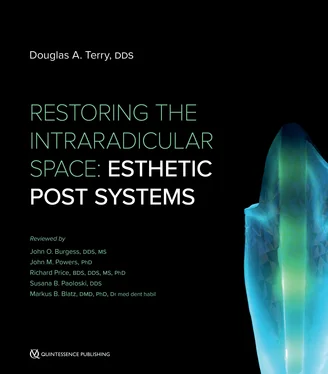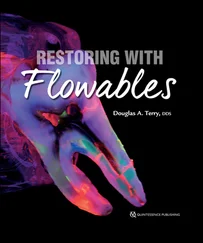1 ...8 9 10 12 13 14 ...18 Incompatibilities have been demonstrated between the self-cured and dual-cured resin cements with specific bonding systems.482 –484 ,486 –492 These incompatibilities can result in increased permeability and hydrolytic degradation of the adhesive layer.212 ,486 Aforementioned materials and techniques have been described to improve compatibility. Furthermore, manufacturers have introduced additional activators to improve compatibility; however, these activators are not always effective.482 ,484 ,486 ,487 ,491 –494 Studies indicate that dilution of the adhesive resin by the activator could adversely affect the hybrid layer.482 ,489 ,490 ,492 ,494 Because not all dual-cured resin cements perform well with all bonding systems and there are incompatibilities among systems, it is recommended that dual-cured resins not be combined with adhesive resin systems from different manufacturers unless compatibility has been demonstrated.482
The bond strengths in different areas of the post channel can be influenced by technique and dentin microanatomy.148 These challenges include insufficient light energy being transmitted to the cement at the apical third of the channel,234 ,495 the concentration of the dentinal tubules that greatly decreases toward the apical region,453 ,472 ,496 the fact that radicular dentin is irregular and may be void of dentinal tubules,453 ,472 and the ability of the operator to apply different conditioners, bonding agents, and cements to these areas in unfavorable conditions.
There is evidence that light transmission of translucent fiber post systems may not be adequate238 ,251 ,453 ,497 ,498; as such, the light intensity of curing units decreases from the coronal to the apical of the post channel for these fiber post systems, 42 ,202 ,238 ,251 and the amount of light reaching the apical third of the post spaces can be insufficient to effectively cure the resin cement. 16 , 42 ,238 ,453 ,499 Therefore, light-cured resin cements are not adequate for luting posts.202 ,346 ,500 While one study reports a fiberoptic post system that had significantly greater light transmission with a light-polymerized resin cement,200 several studies have reported inferior bonding performance in apical regions of the post channel with the use of light-cured adhesives.228 ,469 ,453 ,501 ,502 Additionally, research has demonstrated that the autopolymerizing potential of dual-cured cements alone is not sufficient to achieve maximum hardness of the cement.234 ,503 ,504
There are specific translucent fiber posts that diminish light transmission more than other posts.200 ,236 ,238 ,505 With these translucent posts, the transmission of applied light can be reduced to less than 40%, which can decrease the polymerization of the resin cement.200 ,248 These differences in light transmission among post systems can be correlated to the variations that exist in their fiber diameter, orientation pattern, and matrix. Furthermore, when light is transmitted through the channel post space, its intensity is significantly diminished because of attenuation as it passes through the resin cement and also due to the shadowing caused by the tooth structure and the post.200 ,505 –507 However, light intensity reaching the cement may be sufficient to initiate the polymerization process, while the self-curing catalyst is required to ensure maximum degree of cure.234 However, dual-cured and self-cured resin cements are recommended because of the light attenuation at the increased depths of the post channel.200 ,508
Investigations have demonstrated that no differences are evident between bonding effectiveness of translucent posts and that of light-cured or dual-cured composites.200 ,509 ,510 Some clinicians purport the use of dual-cured resin cements with etch-and-rinse adhesives as an excellent restorative choice, 100 ,202 whereas current evidence suggests that for fiber post cementation the most reliable results are achieved with etch-and-rinse adhesives in combination with dual-cured resin cements. 42 , 100 ,511 Furthermore, studies indicate that etch-and-rinse adhesive systems combined with self- or dual-cured resin cements are used more often than self-etching systems to cement fiber posts.126 ,512 Another systematic review of in vitro literature reported superior retention of fiber posts to dentin with the use of self-adhesive resin cement.149 A systematic review and meta-analysis of in vitro studies indicate that the use of self-adhesive resin cements may improve bond strength of fiber posts to the post channel dentin,149 and this same cement demonstrated less nanoleakage compared to multistep resin cements when fiber posts were luted to the post channel dentin.476 Another study indicated that the performance of a self-adhesive resin cement along the post channel was similar to that of self-cured resin cements and demonstrated that these materials appear to be less dependent upon light irradiation to achieve high bond strength.513 Also, there is evidence that suggests that fiber post bonding is more reliable when utilizing self-adhesive cements468 due to the multiple steps and difficulty in reaching the apex of the post space. Furthermore, several studies reported that resin cement or self-adhesive resin cement resulted in increased bond strength between the fiber post and post channel dentin and improved the fracture resistance of the endodontically treated tooth.439 ,514 Thus, it is well established that the luting procedure plays a significant role in the clinical performance of the restoration of the endodontically treated tooth, and the use of a resin luting cement to line and strengthen the canal walls actually reinforces the root and supports the tooth-restorative complex.166 ,345
Core buildup
The fourth component is the core buildup. The core foundation should provide resistance to repetitive functional forces during mastication while enhancing performance of the supporting restoration.479 ,515 ,516 The most commonly used core materials for the fiber-reinforced post system are glass ionomers, resin-modified glass ionomers, and resin composite. Composites are considered to be unequaled for use as a core buildup in comparison to the glass ionomers. Composites enhance the retention and fracture resistance of the fiber post.166 ,353 ,411 ,433 ,517 –519 In addition, composites possess mechanical characteristics such as fracture toughness and hardness that are similar to tooth structure.411 ,520 And as previously described, the use of these tooth-colored composites with fiber posts provides an optimal color for the substrate and an esthetic appearance of the final restoration.
Various composite materials have been investigated for their use as a core material, including conventional hybrid composites, flowable composites, and bulk-filled composites.411 ,479 ,518 ,521 –524 Manufacturers assert that bulk-filled composites provide a greater depth of polymerization and a reduced polymerization-induced shrinkage stress than conventional hybrid resin composite.479 ,525 One microscopic study indicated that flowable composites achieved structural homogeneity and continuity with the post surface that were superior to hybrid composites.521 Another study reported that flowable core materials create a uniform and tight interdiffusion zone between post surface and the core material.518 One study indicated that specific highly filled flowable materials (G-aenial Universal Flo, G-aenial Flo, and Clearfil Majesty Flow [Kuraray]) had significantly greater flexural strength and a higher elastic modulus than the corresponding conventional nanocomposite materials (Kalore [GC America] and Clearfil Majesty Esthetic [Kuraray]).526 According to the manufacturers, these next-generation (universal) flowable composites offer mechanical, physical, and esthetic properties similar to or better than those of many universal composites.456 ,527 The clinical attributes of universal flowable composites include easier insertion and manipulation, improved adaptation to the internal cavity wall,456 ,528 increased wear resistance, greater elasticity, color stability, enhanced polishability, and polish retention with radiopacity similar to enamel.
Читать дальше












